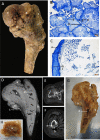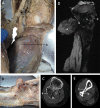An unusual example of hereditary multiple exostoses: a case report and review of the literature
- PMID: 33478453
- PMCID: PMC7818741
- DOI: 10.1186/s12891-021-03967-6
An unusual example of hereditary multiple exostoses: a case report and review of the literature
Abstract
Background: Hereditary multiple exostoses (HME) is a rare skeletal disorder characterised by a widespread. distribution of osteochondromas originating from the metaphyses of long bones.
Case presentation: This case study examines a 55-year-old male cadaver bequeathed to the University of Liverpool who suffered from HME, thus providing an exceptionally rare opportunity to examine the anatomical changes associated with this condition.
Conclusions: Findings from imaging and dissection indicated that this was a severe case of HME in terms of the quantity and distribution of the osteochondromas and the number of synostoses present. In addition, the existence of enchondromas and the appearance of gaps within the trabeculae of affected bones make this a remarkable case. This study provides a comprehensive overview of the morbidity of the disease as well as adding to the growing evidence that diseases concerning benign cartilaginous tumours may be part of a spectrum rather than distinct entities.
Keywords: Diaphyseal aclasis; Enchondroma; Hereditary multiple Exostoses; Metachondromatosis; Osteochondroma; Synostosis.
Conflict of interest statement
The authors declare that they have no competing interests.
Figures




References
-
- DuBose CO. Multiple Hereditary Exostoses. Radiol Technol. 2016;87(3):305–321. - PubMed
-
- Garcia-Gonzalez O, Mireles-Cano JN, Sanchez-Zavala N, Chagolla-Santillan MA, Orozco-Ramirez SM, Silva-Cerecedo P, Murguia-Perez M, Rueda-Franco F. Multiple hereditary osteochondromatosis with spinal cord compression: case report. Childs Nerv Syst. 2018;34(3):565–569. doi: 10.1007/s00381-017-3645-1. - DOI - PubMed
Publication types
MeSH terms
LinkOut - more resources
Full Text Sources
Other Literature Sources
Medical

